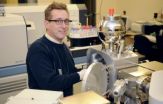Preteen conduct problems leads to teenage serious violence and delinquency
Universite de Montreal study examines early indicators of criminal lifestyle
2010-12-16
(Press-News.org) Montreal, December 15, 2010 – Conduct disorders in preteens are predictive of eventual teenage serious violent and delinquent behavior, according to a new study from the Université de Montréal. The findings, published in this month's issue of Journal of Child Psychology and Psychiatry, have implications for concerned parents.
Preteens who steal, destroy property, fight and bully are six times as likely to sell illicit drugs, nine times as likely to join a gang, 11 times as likely to carry a weapon and eight times as likely to be arrested as a future teenager, according to principle author, Éric Lacourse, a researcher at the Groupe de recherche sur l'inadaptation psychosociale chez l'enfant (GRIP) at the Université de Montréal.
"At ages 12 and 13, the behaviors that lead to delinquency are well documented," says Lacourse. "However, intervention programs are mostly targeted to younger children and very little help is available for kids preteens."
Two-year study
The study examined three groups of 12 and 13-year-old Canadian kids over a span of two years. The group consisted of 4,125 test-subjects who were classified according to precise symptoms of conduct disorders.
"Children with conduct disorders who are not violent are also more likely to adopt serious delinquent behaviors as teenagers," says Lacourse. "More specifically, this group is three times as likely to sell illicit drugs, four times as likely to join a gang, and three times as likely to mug someone using a weapon."
Lacourse believes the definition of conduct disorders in the Diagnostic and Statistical Manual of Mental Disorders (DSM) should be reviewed. Currently, it defines the disorder as a combination of any three symptoms on a list of 15. "The list is partly deficient because it doesn't apply to all cases," says Lacourse. "And it's also partly wieldy because it allows for 30,000 possible combinations."
INFORMATION:
About the study:
"Two-year predictive validity of conduct disorder subtypes in early adolescence: a latent class analysis of a Canadian longitudinal sample" was authored by E. Lacourse R. Baillargeon, V. Dupéré, F. Vitaro, E. Romano and R Tremblay from the Université de Montréal
On the Web:
Université de Montréal: www.umontreal.ca/english
Cited Journal of Child Psychology and Psychiatry study: http://www.blackwellpublishing.com/journal.asp?ref=0021-9630
Media contact:
Julie Gazaille
Press attaché
University of Montreal
Telephone: 514 343 6796
Email: j.cordeau-gazaille@umontreal.ca
Twitter: http://twitter.com/uMontreal_news
ELSE PRESS RELEASES FROM THIS DATE:
2010-12-16
With chitlins about to make their annual appearance on Christmas and New Year's Day menus, scientists have good news for millions of people who love that delicacy of down-home southern cooking, but hate the smell. They are reporting the first identification of an ingredient in cilantro that quashes the notoriously foul odor of chitlins — a smell known to drive people from the house when chitlins are cooking. Their report appears in ACS' Journal of Agricultural and Food Chemistry.
Yasuyoshi Hayata and colleagues note that chitlins — hog large intestines — are infamous ...
2010-12-16
A mounting tide of scientific evidence suggests that the old adage from Aesop's fables — "You are known by the company you keep" — also applies to the trillions of microscopic bacteria and viruses that live on the human body. Humanity's invisible but constant companions — more bacteria hang out on the palms of your hands than there are people on Earth — is the topic of an article in the current edition of Chemical & Engineering News (C&EN), ACS' weekly newsmagazine.
C&EN Associate Editor Sarah Everts notes in the article that the astonishing diversity of microbes inhabiting ...
2010-12-16
The virus that causes AIDS is chameleon-like in its replication. As HIV copies itself in humans, it constantly mutates into forms that can evade even the best cocktail of current therapies. Understanding exactly how HIV cells change as they reproduce is key to developing better tests and treatments for patients.
In the Journal of Biological Chemistry and Nature Structural & Molecular Biology, MU microbiologist and biochemist Stefan Sarafianos, PhD, reveals new findings that shed light on how HIV eludes treatment by mutating. His discoveries provide clues into HIV's mechanisms ...
2010-12-16
For the first time in history, a change will be made to the atomic weights of some elements listed on the Periodic table of the chemical elements posted on walls of chemistry classrooms and on the inside covers of chemistry textbooks worldwide.
The new table, outlined in a report released this month, will express atomic weights of 10 elements - hydrogen, lithium, boron, carbon, nitrogen, oxygen, silicon, sulfur, chlorine and thallium - in a new manner that will reflect more accurately how these elements are found in nature.
"For more than a century and a half, many ...
2010-12-16
CHAMPAIGN, Ill. — University of Illinois researchers have found a key to keeping stem cells in their neutral state: It takes a soft touch.
In a paper published in the journal PLoS One, the researchers demonstrated that culturing mouse embryonic stem cells (mESCs) on a soft gel rather than on a hard plate or dish keeps them in their pluripotent state, a ground state with the ability to become any type of tissue. The soft substrate maintains homogeneous pluripotent colonies over long periods of time – without the need for expensive growth chemicals.
"This has huge applications ...
2010-12-16
Red tides and similar blooms can render some seafood unsafe to eat, though it can be difficult to tell whether a particular batch harbors toxins that cause food poisoning.
A new kind of marker developed by chemists at the University of California, San Diego, and reported in the journal ChemComm makes it easier to see if shellfish are filled with toxin-producing organisms.
Mussels and oysters accumulate single-celled marine creatures called dinoflagellates in their digestive systems as they filter seawater for food. Usually dinoflagellates are harmless, but sometimes ...
2010-12-16
CHAMPAIGN, Ill. — Fortified with iron: It's not just for breakfast cereal anymore. University of Illinois researchers have demonstrated a simpler method of adding iron to tiny carbon spheres to create catalytic materials that have the potential to remove contaminants from gas or liquid.
Civil and environmental engineering professor Mark Rood, graduate student John Atkinson and their team described their technique in the journal Carbon.
Carbon structures can be a support base for catalysts, such as iron and other metals. Iron is a readily available, low-cost catalyst ...
2010-12-16
Using an automated screening technique developed by pharmaceutical companies to find new drugs, a team of researchers from UC San Diego and three other research institutions has discovered a molecule with the most potent effects ever seen on the biological clock.
Dubbed by the scientists "longdaysin," for its ability to dramatically slow down the biological clock, the new compound and the application of their screening method to the discovery of other clock-shifting chemicals could pave the way for a host of new drugs to treat severe sleep disorders or quickly reset the ...
2010-12-16
Los Angeles, CA (December 15, 2010) Being a part of many different social groups can improve mental health and help a person cope with stressful events. It also leads to better physical health, making you more able to withstand—and recover faster from—physical challenges, according to a study in the current Social Psychological and Personality Science (published by SAGE).
Belonging to groups, such as networks of friends, family, clubs and sport teams, improves mental health because groups provide support, help you to feel good about yourself and keep you active. But ...
2010-12-16
Los Angeles, CA (December 15, 2010) When computerized neuropsychological testing is used, high school athletes suffering from a sports-related concussion are less likely to be returned to play within one week of their injury, according to a study in The American Journal of Sports Medicine (published by SAGE). Unfortunately, concussed football players are less likely to have computerized neuropsychological testing than those participating in other sports.
A total of 544 concussions were recorded by the High School Reporting Information Online surveillance system during ...
LAST 30 PRESS RELEASES:
[Press-News.org] Preteen conduct problems leads to teenage serious violence and delinquency
Universite de Montreal study examines early indicators of criminal lifestyle


